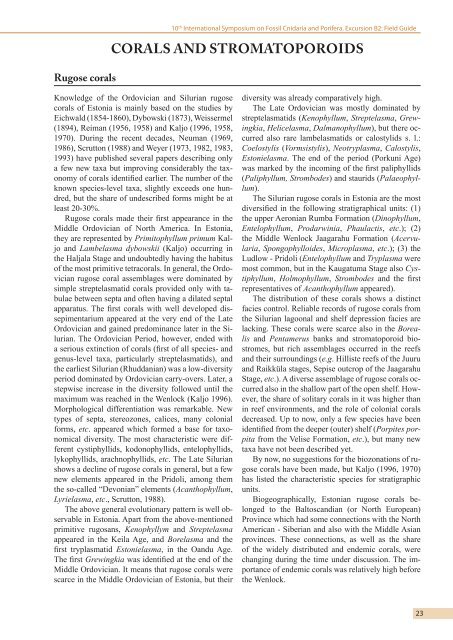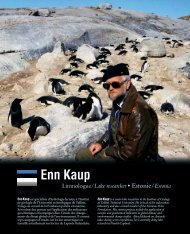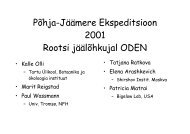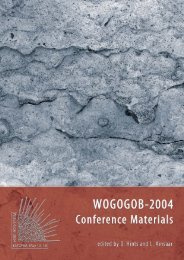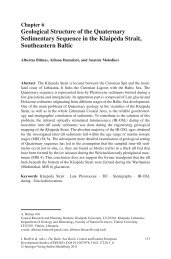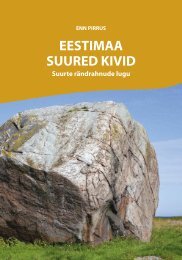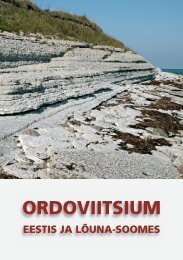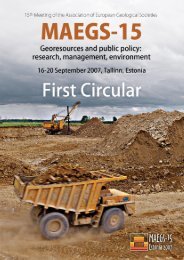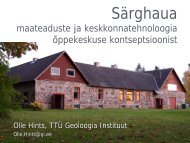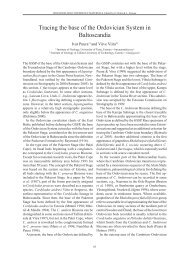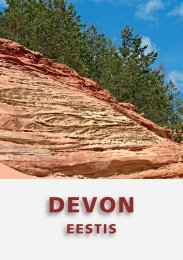Excursion Guidebook - Geoloogia Instituut
Excursion Guidebook - Geoloogia Instituut
Excursion Guidebook - Geoloogia Instituut
You also want an ePaper? Increase the reach of your titles
YUMPU automatically turns print PDFs into web optimized ePapers that Google loves.
Rugose corals10 th International Symposium on Fossil Cnidaria and Porifera. <strong>Excursion</strong> B2: Field GuideCorals and stromatoporoidsKnowledge of the Ordovician and Silurian rugosecorals of Estonia is mainly based on the studies byEichwald (1854-1860), Dybowski (1873), Weissermel(1894), Reiman (1956, 1958) and Kaljo (1996, 1958,1970). During the recent decades, Neuman (1969,1986), Scrutton (1988) and Weyer (1973, 1982, 1983,1993) have published several papers describing onlya few new taxa but improving considerably the taxonomyof corals identified earlier. The number of theknown species-level taxa, slightly exceeds one hundred,but the share of undescribed forms might be atleast 20-30%.Rugose corals made their first appearance in theMiddle Ordovician of North America. In Estonia,they are represented by Primitophyllum primum Kaljoand Lambelasma dybowskii (Kaljo) occurring inthe Haljala Stage and undoubtedly having the habitusof the most primitive tetracorals. In general, the Ordovicianrugose coral assemblages were dominated bysimple streptelasmatid corals provided only with tabulaebetween septa and often having a dilated septalapparatus. The first corals with well developed dissepimentariumappeared at the very end of the LateOrdovician and gained predominance later in the Silurian.The Ordovician Period, however, ended witha serious extinction of corals (first of all species- andgenus-level taxa, particularly streptelasmatids), andthe earliest Silurian (Rhuddanian) was a low-diversityperiod dominated by Ordovician carry-overs. Later, astepwise increase in the diversity followed until themaximum was reached in the Wenlock (Kaljo 1996).Morphological differentiation was remarkable. Newtypes of septa, stereozones, calices, many colonialforms, etc. appeared which formed a base for taxonomicaldiversity. The most characteristic were differentcystiphyllids, kodonophyllids, entelophyllids,lykophyllids, arachnophyllids, etc. The Late Silurianshows a decline of rugose corals in general, but a fewnew elements appeared in the Pridoli, among themthe so-called “Devonian” elements (Acanthophyllum,Lyrielasma, etc., Scrutton, 1988).The above general evolutionary pattern is well observablein Estonia. Apart from the above-mentionedprimitive rugosans, Kenophyllym and Streptelasmaappeared in the Keila Age, and Borelasma and thefirst tryplasmatid Estonielasma, in the Oandu Age.The first Grewingkia was identified at the end of theMiddle Ordovician. It means that rugose corals werescarce in the Middle Ordovician of Estonia, but theirdiversity was already comparatively high.The Late Ordovician was mostly dominated bystreptelasmatids (Kenophyllum, Streptelasma, Grewingkia,Helicelasma, Dalmanophyllum), but there occurredalso rare lambelasmatids or calostylids s. l.:Coelostylis (Vormsistylis), Neotryplasma, Calostylis,Estonielasma. The end of the period (Porkuni Age)was marked by the incoming of the first paliphyllids(Paliphyllum, Strombodes) and staurids (Palaeophyllum).The Silurian rugose corals in Estonia are the mostdiversified in the following stratigraphical units: (1)the upper Aeronian Rumba Formation (Dinophyllum,Entelophyllum, Prodarwinia, Phaulactis, etc.); (2)the Middle Wenlock Jaagarahu Formation (Acervularia,Spongophylloides, Microplasma, etc.); (3) theLudlow - Pridoli (Entelophyllum and Tryplasma weremost common, but in the Kaugatuma Stage also Cystiphyllum,Holmophyllum, Strombodes and the firstrepresentatives of Acanthophyllum appeared).The distribution of these corals shows a distinctfacies control. Reliable records of rugose corals fromthe Silurian lagoonal and shelf depression facies arelacking. These corals were scarce also in the Borealisand Pentamerus banks and stromatoporoid biostromes,but rich assemblages occurred in the reefsand their surroundings (e.g. Hilliste reefs of the Juuruand Raikküla stages, Sepise outcrop of the JaagarahuStage, etc.). A diverse assemblage of rugose corals occurredalso in the shallow part of the open shelf. However,the share of solitary corals in it was higher thanin reef environments, and the role of colonial coralsdecreased. Up to now, only a few species have beenidentified from the deeper (outer) shelf (Porpites porpitafrom the Velise Formation, etc.), but many newtaxa have not been described yet.By now, no suggestions for the biozonations of rugosecorals have been made, but Kaljo (1996, 1970)has listed the characteristic species for stratigraphicunits.Biogeographically, Estonian rugose corals belongedto the Baltoscandian (or North European)Province which had some connections with the NorthAmerican - Siberian and also with the Middle Asianprovinces. These connections, as well as the shareof the widely distributed and endemic corals, werechanging during the time under discussion. The importanceof endemic corals was relatively high beforethe Wenlock.23


